Learn how to make a perfectly buttery, flaky pie crust from scratch using this in-depth tutorial and video. This page includes all of my best success tips, lots of step-by-step photos, and a thoroughly detailed recipe. Millions of readers have been using this helpful guide since 2015. Become a pro with this crust recipe and the rest will be as easy as… eating salted caramel apple pie!
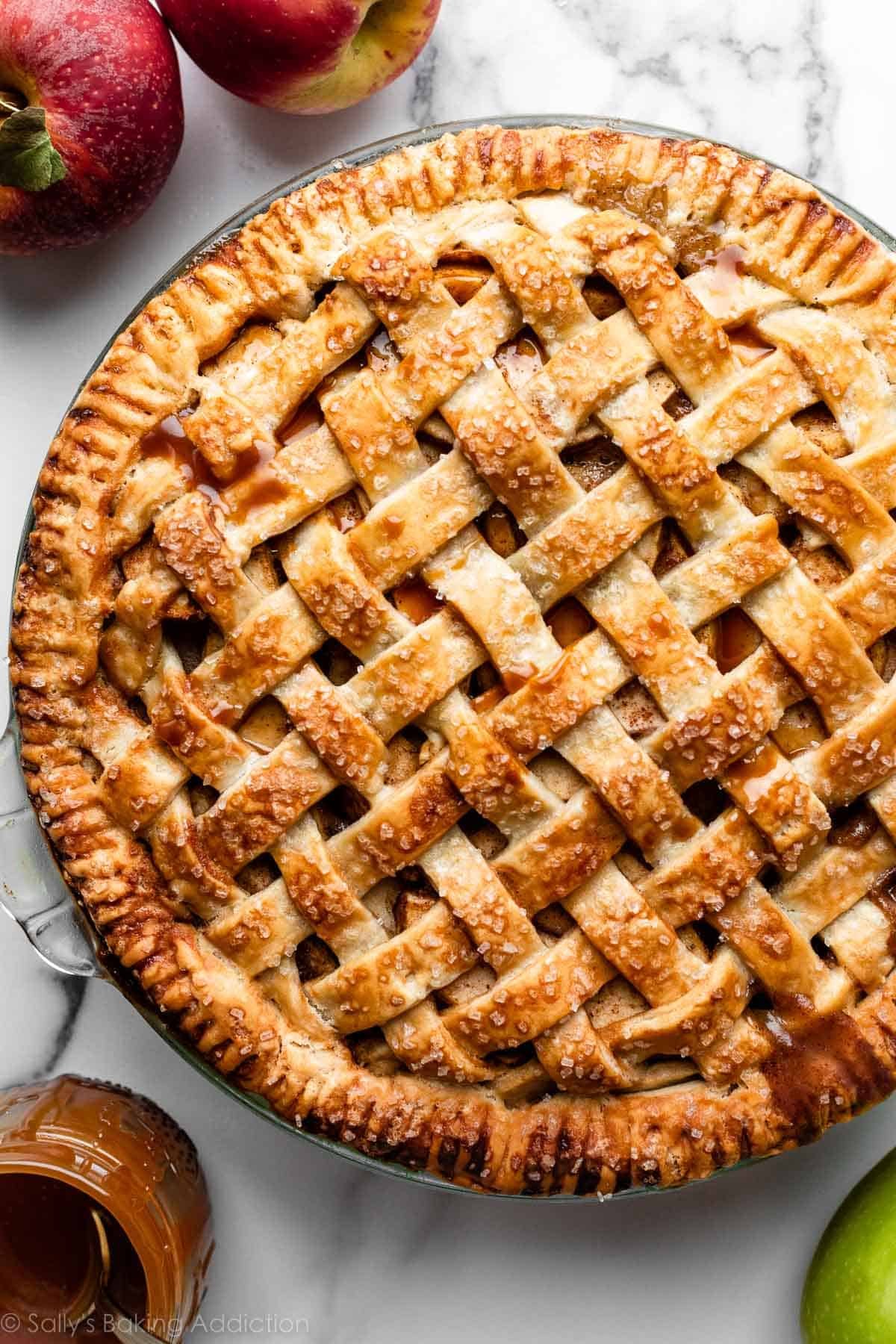
For a baker, there’s nothing more satisfying than making a pie completely from scratch. Pies are often made for special occasions, and there’s a good reason for that: they’re time consuming. This shouldn’t scare you! It should intrigue you. If you’ve ever felt intimidated about making homemade pie crust, I’m here to walk you through it and cheer you on. If I can do this, you can do this.
Pie crust is the foundation for so many delicious desserts (plus savory pies and quiche), so once you build up your confidence in making a crust, you’re opening a door to an entire baking category. And that’s exciting! Whether your favorite pie filling is apple pie or creamy banana cream pie, or even eggs & cheese, the success of the overall pie can really hinge on the quality of the crust.
You wouldn’t hang a beautiful piece of art or favorite photo in a terrible frame, right?
Today I’m teaching you everything about making a buttery, flaky pie crust. This is my absolute favorite pie crust recipe and one of the most popular recipes on this website.
With all the recipe testing that goes into publishing the many pie recipes on this website and in my cookbooks, plus my annual Pie Week, it’s not an understatement to say that I have made a LOT of pies. Along the way, I’ve learned what works and what doesn’t, and I’m happy to share it all with you.
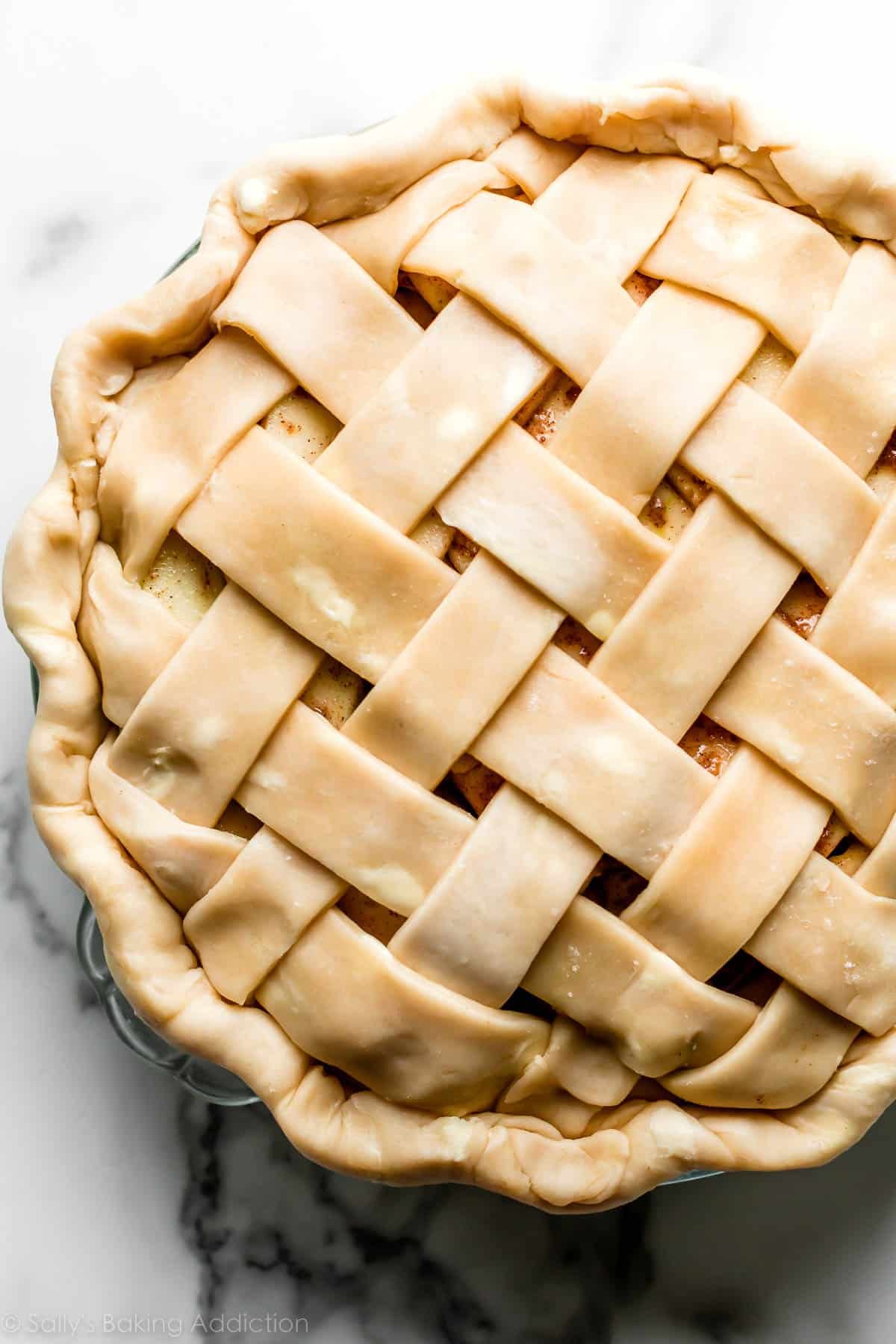
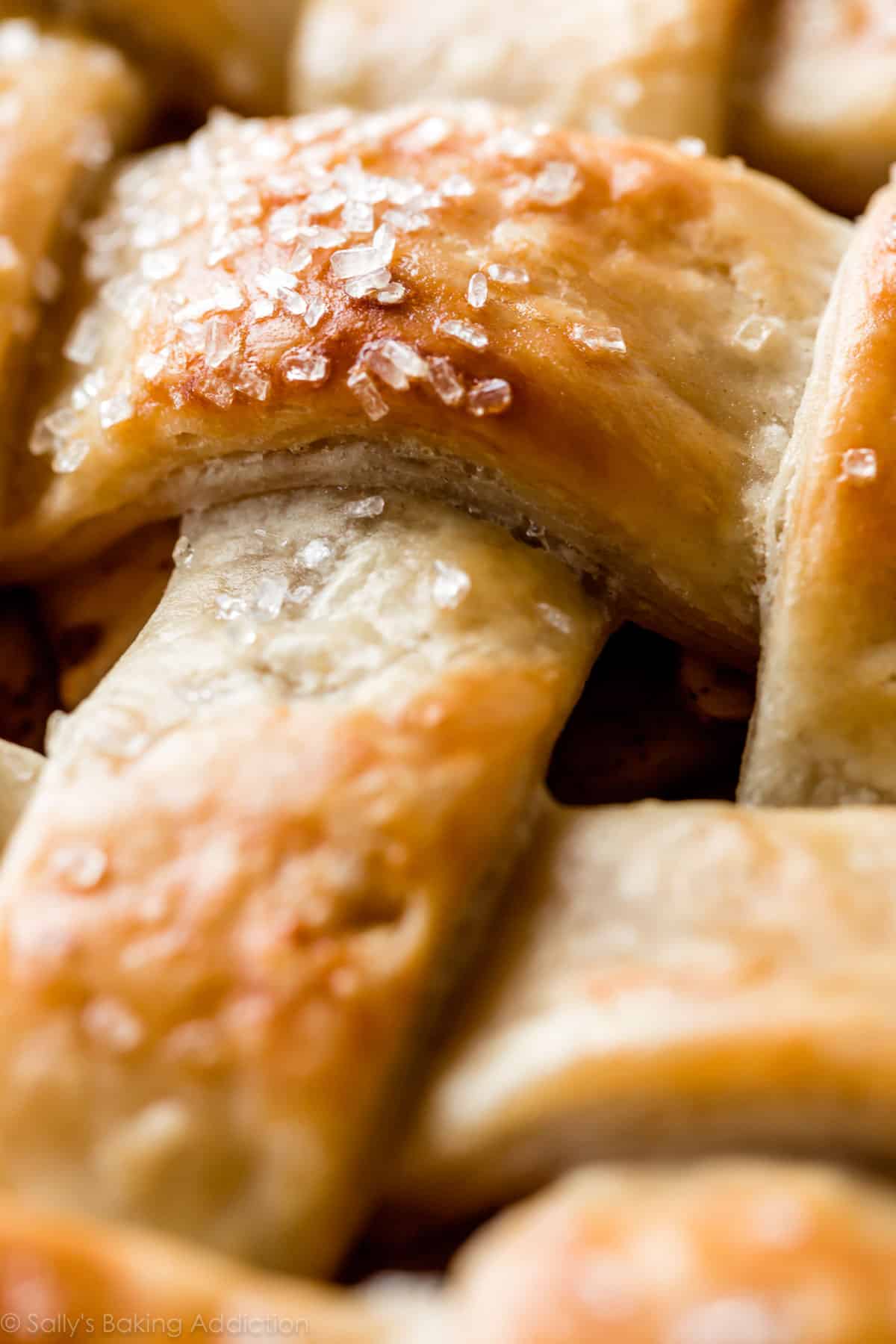
Start With These 5 Ingredients
The ingredient list for pie crust is short & simple:
- Flour: Start with quality flour. Did you know that not all all-purpose flours are equal? King Arthur Unbleached All-Purpose Flour is my go-to for not only pie crust, but for everything. (Not working with the brand, just a true fan!) Why? Its high protein level: “At 11.7% protein, it tops ordinary American all-purpose flours by nearly 2 percentage points.” What does this mean? Baked goods rise higher and stay fresh longer.
- Salt: Enhances the flavor.
- Butter: For that unparalleled buttery flavor and flaky layers.
- Vegetable Shortening: For structure and stability. More on this below.
- Ice water: Liquid brings the dough together. Some recipes call for half water and half vodka, because alcohol doesn’t promote gluten formation, which helps the crust stay flaky and tender. Basically, it’s a gift to anyone who accidentally overworks dough. If you want to try using vodka, use 1/4 cup (60ml) each cold vodka and cold water in this recipe.
You can use this pie dough for so many recipes beyond a traditional pie, too, such as mini pecan pies, mini fruit galettes, apple hand pies, and homemade brown sugar cinnamon pop tarts.
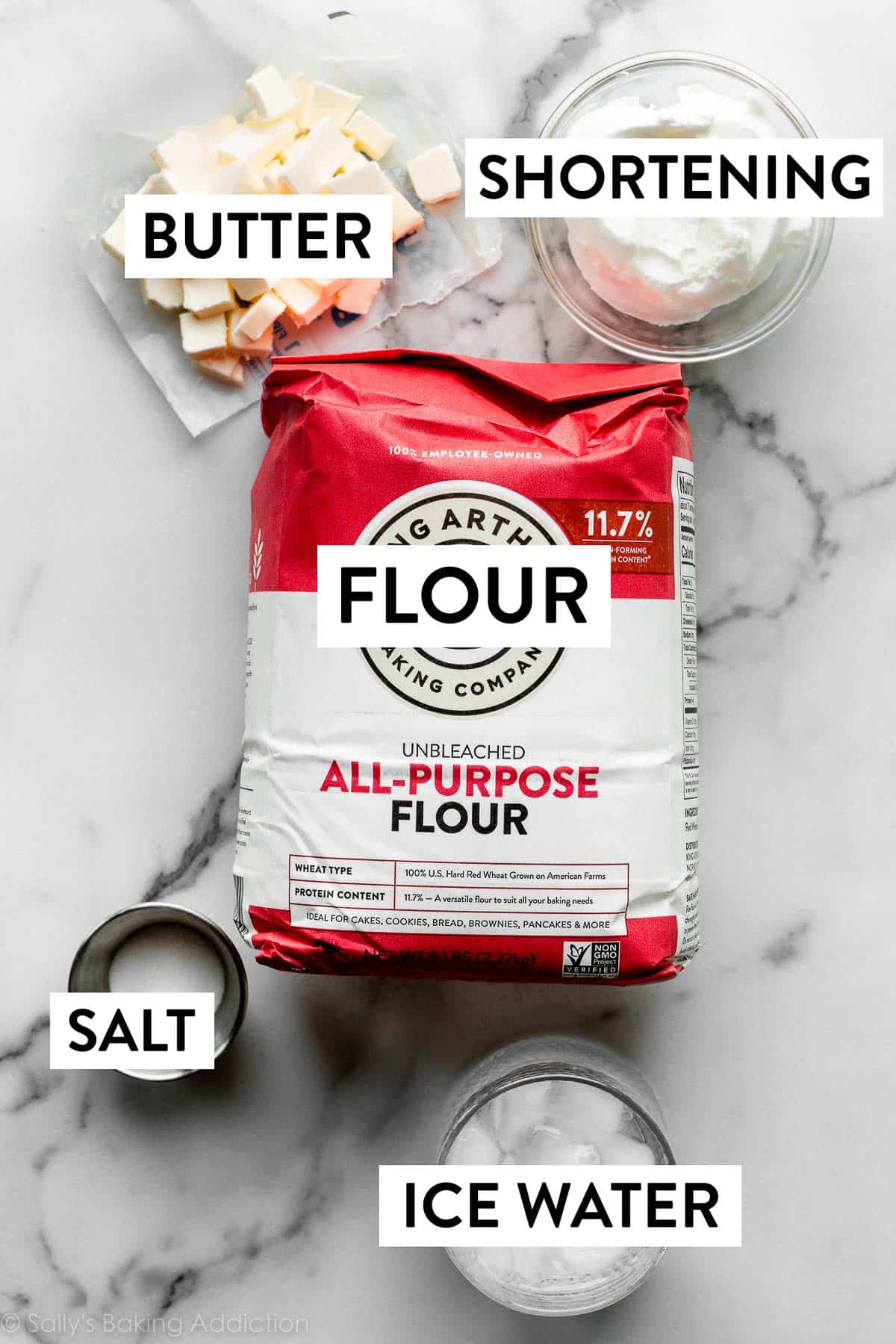
Is Pie Crust Better With Butter or Shortening?
I use BOTH shortening and butter in this pie crust because they work together to make the BEST crust. Buttery, flaky, and tender: the pie-fect trifecta.
- What does butter do? Butter adds flavor and flakiness.
- What does shortening do? Shortening helps the dough stay pliable, which is helpful when you’re rolling and shaping it. Plus, shortening’s high melting point helps the crust stay tender and maintain its shape as it bakes. Have you ever had a butter pie crust lose its shape completely? Shortening is “shape insurance.” 😉
If you don’t want to use shortening, try this all-butter pie crust instead. Let’s compare:
- Using all butter creates a lighter-textured crust and this is due to the butter’s water content. As the crust bakes, the butter’s water converts to steam, lifting up the dough and creating flaky layers. But because of all this butter, the crust doesn’t usually have a perfectly neat-edge/shape compared to the shortening and butter combination.
Both crusts taste buttery and flaky. But overall, this butter-and-shortening crust wins in terms of texture and flavor; AND, if you follow the pie crust recipe carefully, it holds shape too.
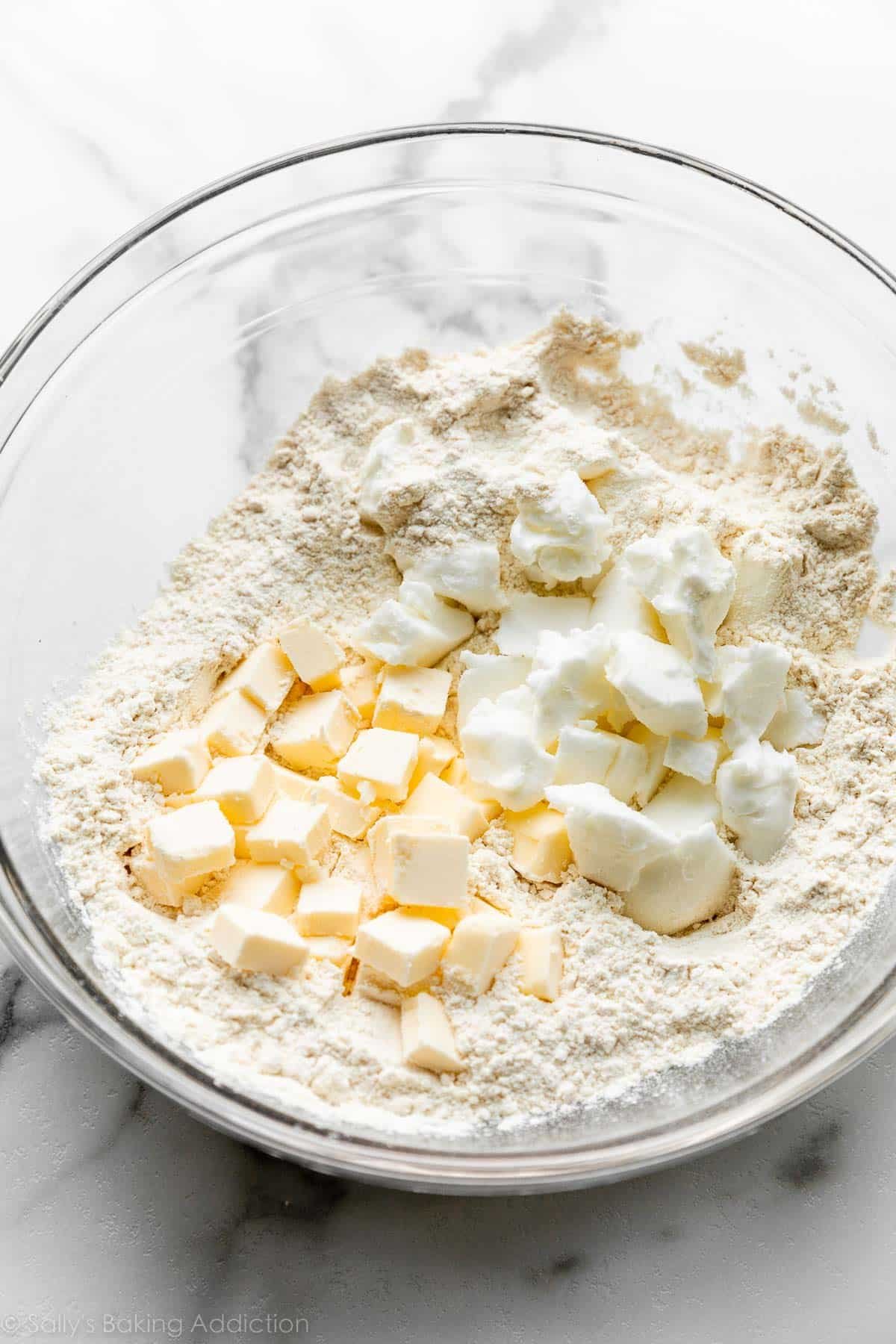
The Secret to Perfect Pie Crust: COLD
The refrigerator is as important as the oven when you’re making a homemade pie.
Why the emphasis on temperature? Keeping your pie dough as cold as possible helps prevent the fats from melting before the crust hits the hot oven. If the butter melts inside the dough before baking, you lose the flakiness. When the lumps of fat melt in the oven as the pie bakes, their steam helps to separate the crust into multiple flaky layers, as explained above. Warm fats will yield a hard, crunchy, greasy crust instead of a tender, flaky crust.
The colder the ingredients, the easier your pie crust is to work with, and the better it will turn out.
Two Tricks to Start as Cold as Possible:
- I keep some of my butter in the freezer and transfer it to the refrigerator a few hours before beginning the crust. This way it is still a little bit frozen and very, very cold. Simply keep the shortening in the refrigerator.
- Mix the dry ingredients together in a large bowl (the flour and salt). Place the bowl in the refrigerator or freezer while you get the rest of the ingredients ready.
These Step-By-Step Photos Will Help
Take the butter and shortening out of the refrigerator. Cube the cold butter and measure out the cold shortening. Give the shortening a little chop—this is actually optional because, truly, the shortening is quite soft even when cold so it’s easy to mix in.
Now it’s time to combine everything. Add the butter and shortening to the dry ingredients, and use a pastry cutter (or 2 forks) to cut in the fats. Some pie crust recipes use a food processor for this, but I don’t recommend it, because it can lead to overworking the fats into the dough, cutting them up too small—which means you’ll need less water and your dough will fall apart. In this step, you’re only breaking up the cold fat into tiny little flour-coated pieces; you’re not completely incorporating it:
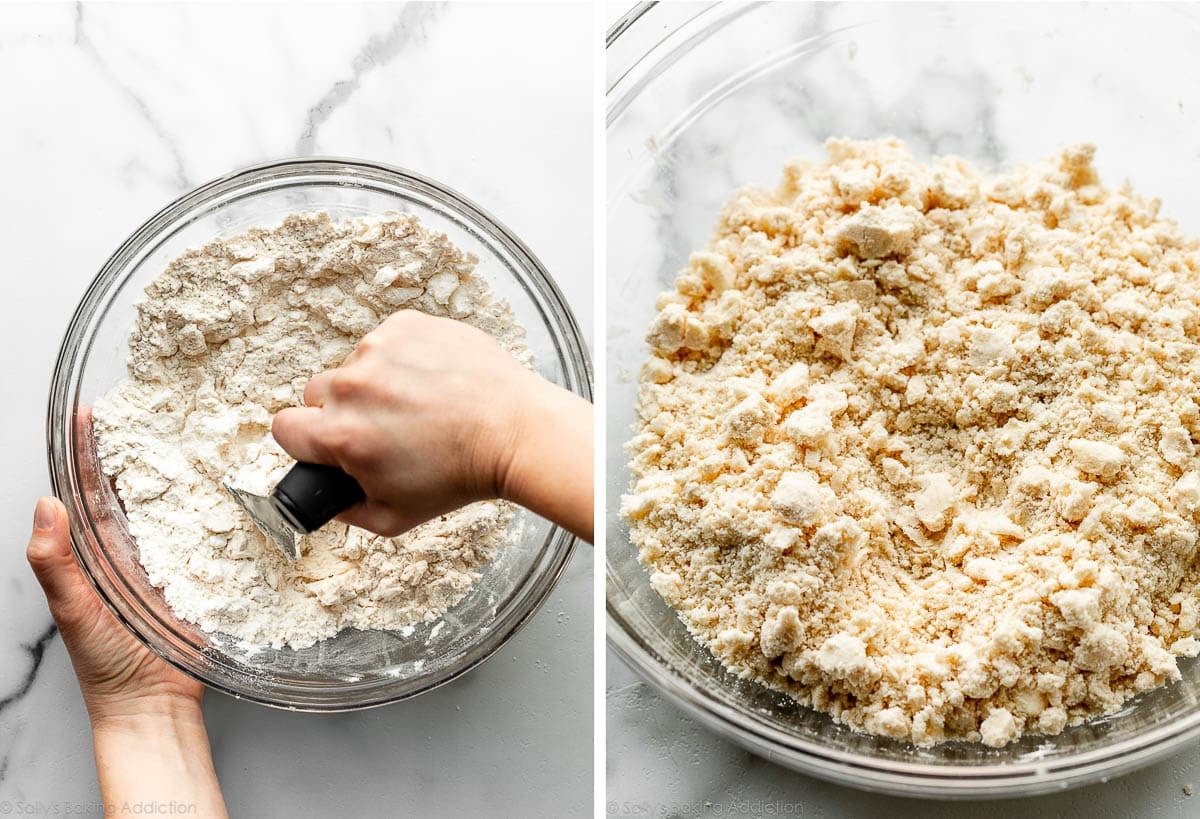
Cut in the fats until the mixture resembles coarse meal—crumbly with lots of lumps, as you see above. You should still have some larger pieces of butter and shortening when you’re done.
From a cup of ice water, measure out 1/2 cup (120ml), since the ice has melted a bit. Drizzle the cold water into the dough 1 Tablespoon (15ml) at a time, stirring after every Tablespoon has been added.
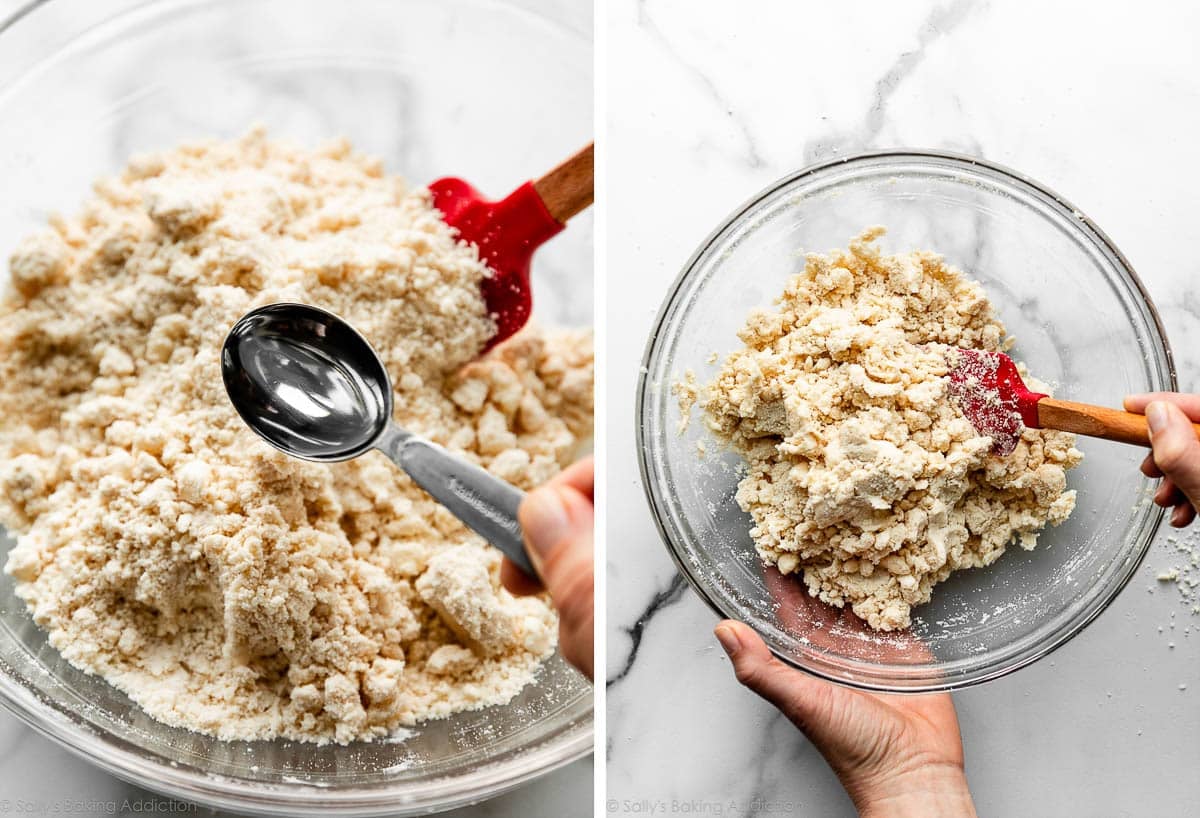
You’ll add just a little water at a time so that you don’t accidentally add too much. Stop adding water when the dough begins to form large clumps. I usually use 1/2 cup (120ml) of water, but if the weather is humid, you may not need as much, and if the weather is really dry, you may need a little more.
If too much water is added, the pie dough will require more flour and become tough.
If too little water is added, you’ll notice the dough is dry and crumbly when you try to roll it out and handle it.
You want the dough to clump together, but not feel overly sticky. Once the dough is clumping together, transfer the dough to a floured work surface.
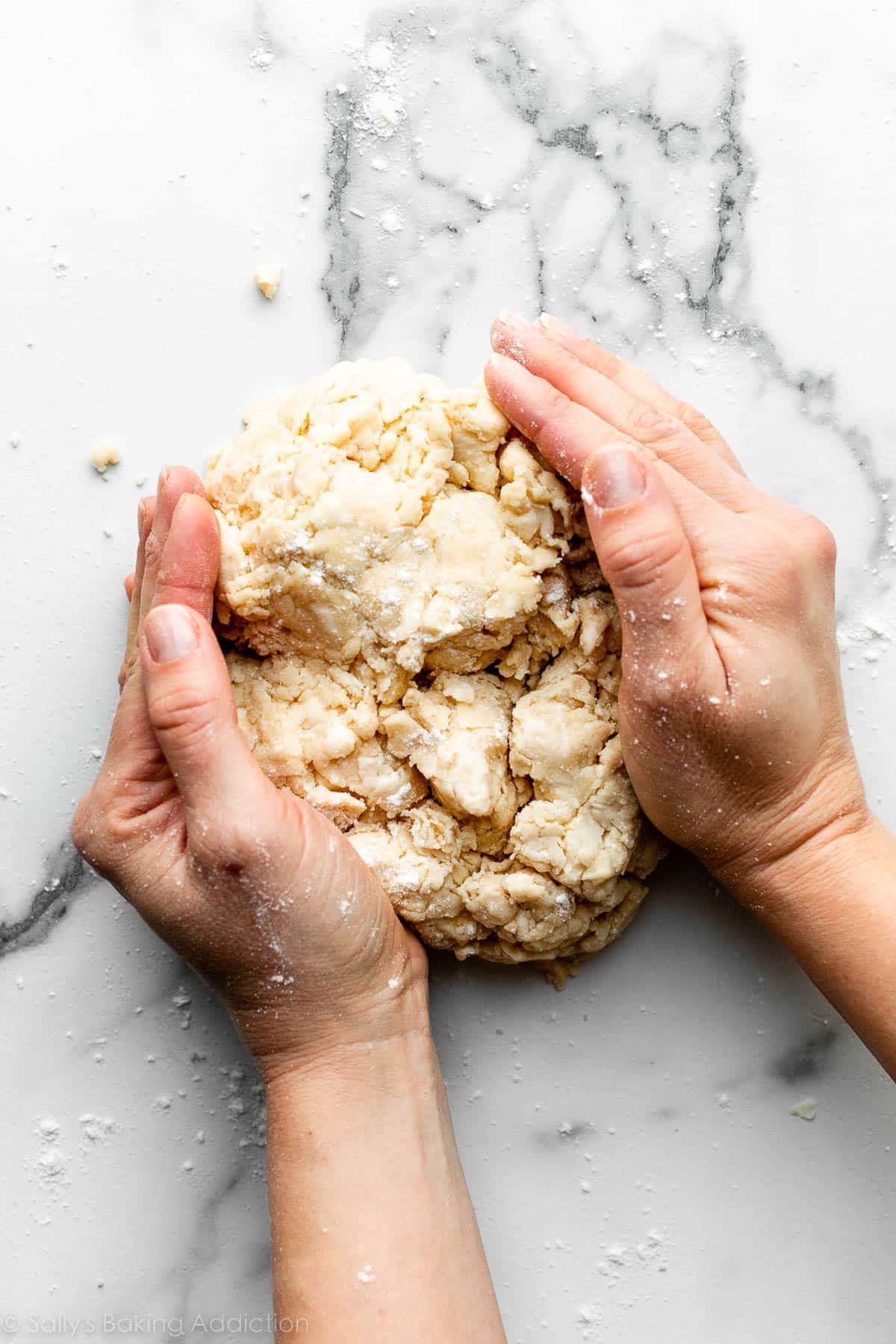
Using floured hands, fold and smush (yes, that’s the technical term) the dough into itself, forming the dough into a ball. Your hands are your best tool, just like when making homemade puff pastry.
The ball of dough should come together easily. If it feels a bit too dry or crumbly, dip your fingers in the ice water and then continue forming the dough with your hands. If it feels too sticky, sprinkle on more flour and then continue forming the dough with your hands.
Once your ball of pie dough has come together, use a sharp knife to cut it in half:
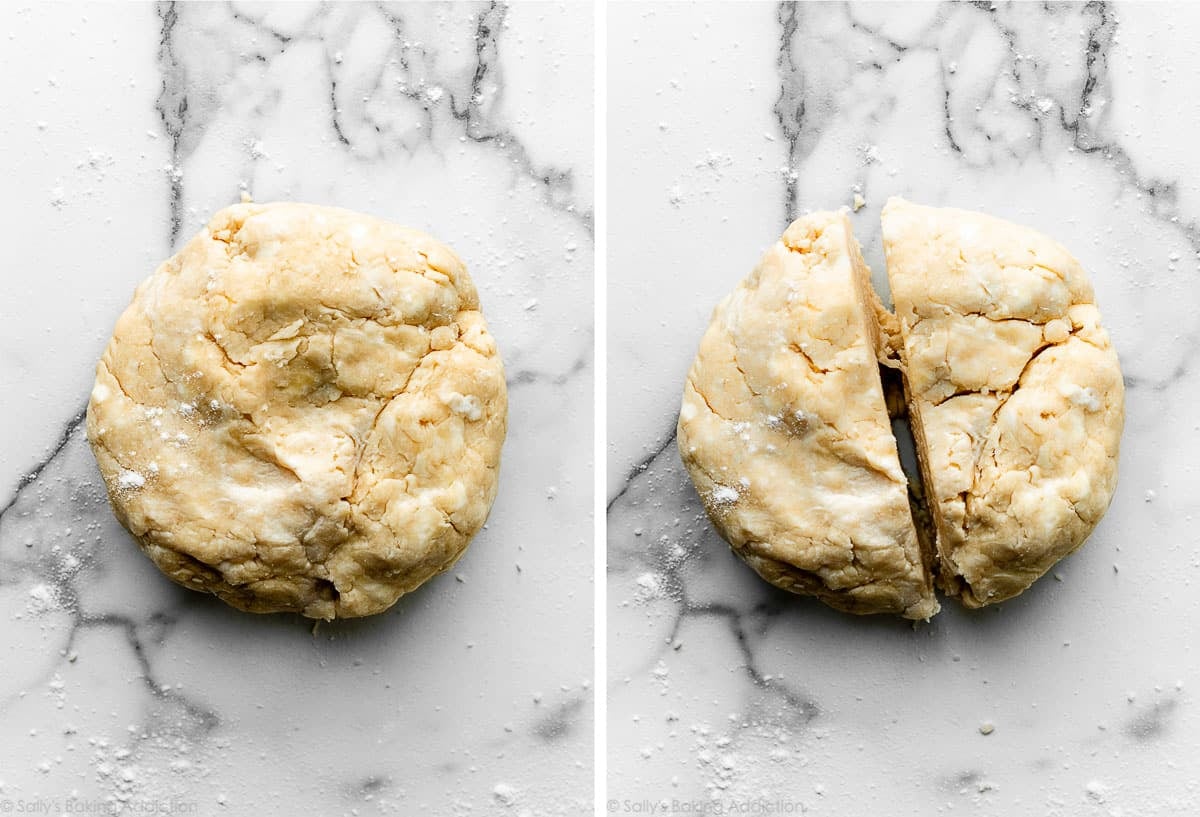
This is enough dough for 2 pie crusts. You can use both crusts for a double-crust pie, like chicken pot pie and strawberry rhubarb pie; or, if your pie doesn’t require a top crust, like coconut cream pie, brownie pie, and lemon meringue pie, save the second pie crust for another pie. You can also roll out the second dough and use cookie cutters to make an easy pie design, like on this pumpkin pie.
Success Tip: Visible Specks and Swirls of Fat in Pie Dough
Take a look at the inside of the dough where you just sliced it. You want to see pieces of butter and flaky layers throughout the pie dough. These specks and swirls of butter and shortening will help ensure a flaky pie dough. They are a GOOD thing!
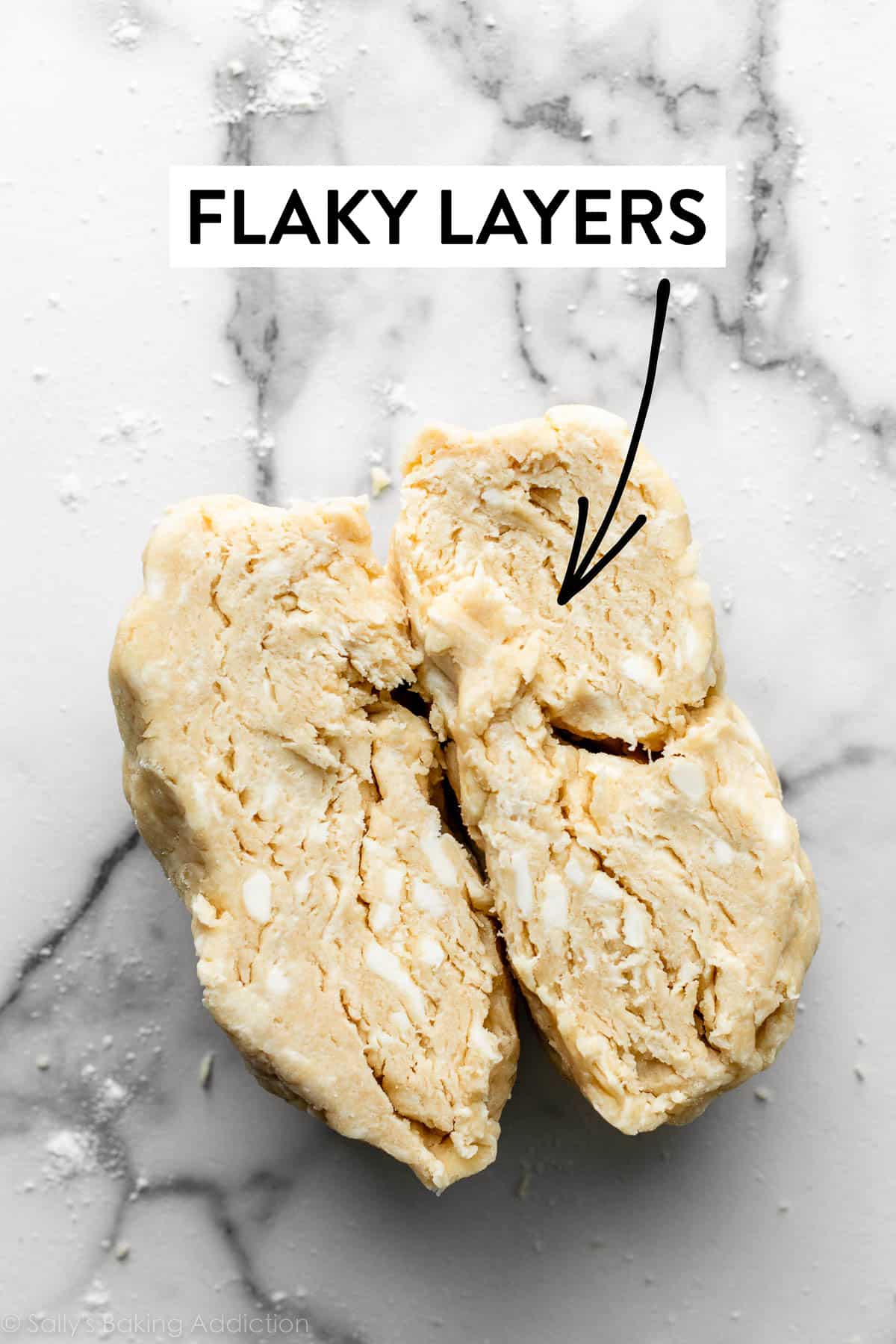
Now your pie dough is ready for a rest in the refrigerator. Flatten each half into 1-inch-thick discs using your hands. The disc shape makes it easier to roll out. Wrap each disc tightly in plastic wrap.
Refrigerate for at least 2 hours or up to 5 days.

Can I Freeze Pie Dough?
Yes, absolutely, and I encourage it! Pie crust freezes beautifully, so it’s a great thing to make ahead of time. Store the tightly wrapped discs of pie dough in the freezer for up to 3 months.
If you know you’re going to want several pies around the holidays, or when your favorite fruit will be in season (cherry pie, anyone?), you can cut down on the amount of time it takes to make pies from scratch the day you want them by making several pie crusts in advance and freezing them.
Thaw the pie crust dough overnight in the refrigerator before rolling it out. It will be extra cold, which is a great starting point.
How to Roll Out Pie Crust
After the dough has chilled for at least 2 hours, you can roll it out. Work with one crust at a time, keeping the other in the refrigerator until you’re ready to roll it out. You’ll need a clean work surface, a rolling pin, and some flour. Lightly flour the work surface, rolling pin, and your hands, and sprinkle a little flour on top of the dough. Use gentle-medium force with your rolling pin on the dough—don’t press down too hard on the dough; you’re not mad at it!
When rolling dough out, start from the center and work your way out in all directions, turning the dough with your hands as you go:
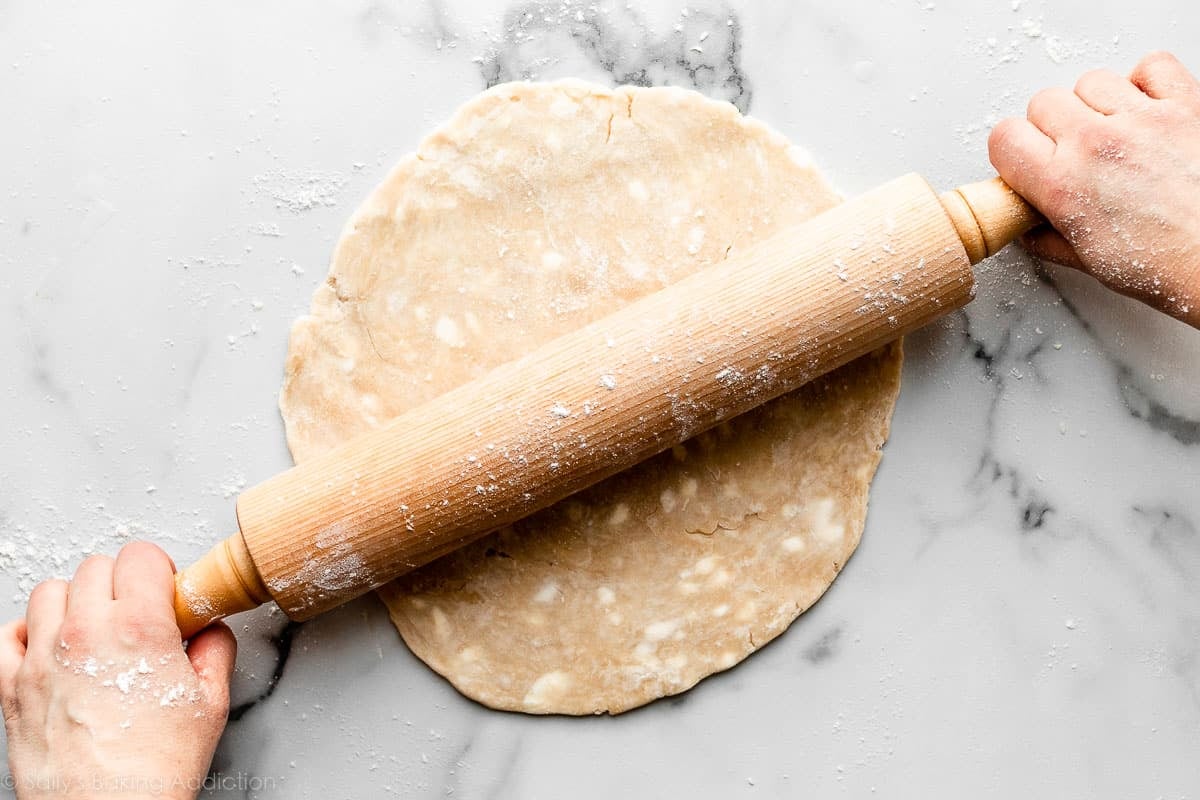
Between passes of the rolling pin, rotate the pie crust and even flip it, to make sure it’s not sticking to your work surface. Sprinkle on a little more flour if it’s sticking. Roll, turn. Roll, turn.
Do you see that beautiful marbling of the butter and shortening throughout the dough? Flaky layers, here you come!
Success Tip: If you notice the dough becoming a lopsided circle as you’re rolling it out, put down the rolling pin and use your hands to help mold the dough back into an even circle:
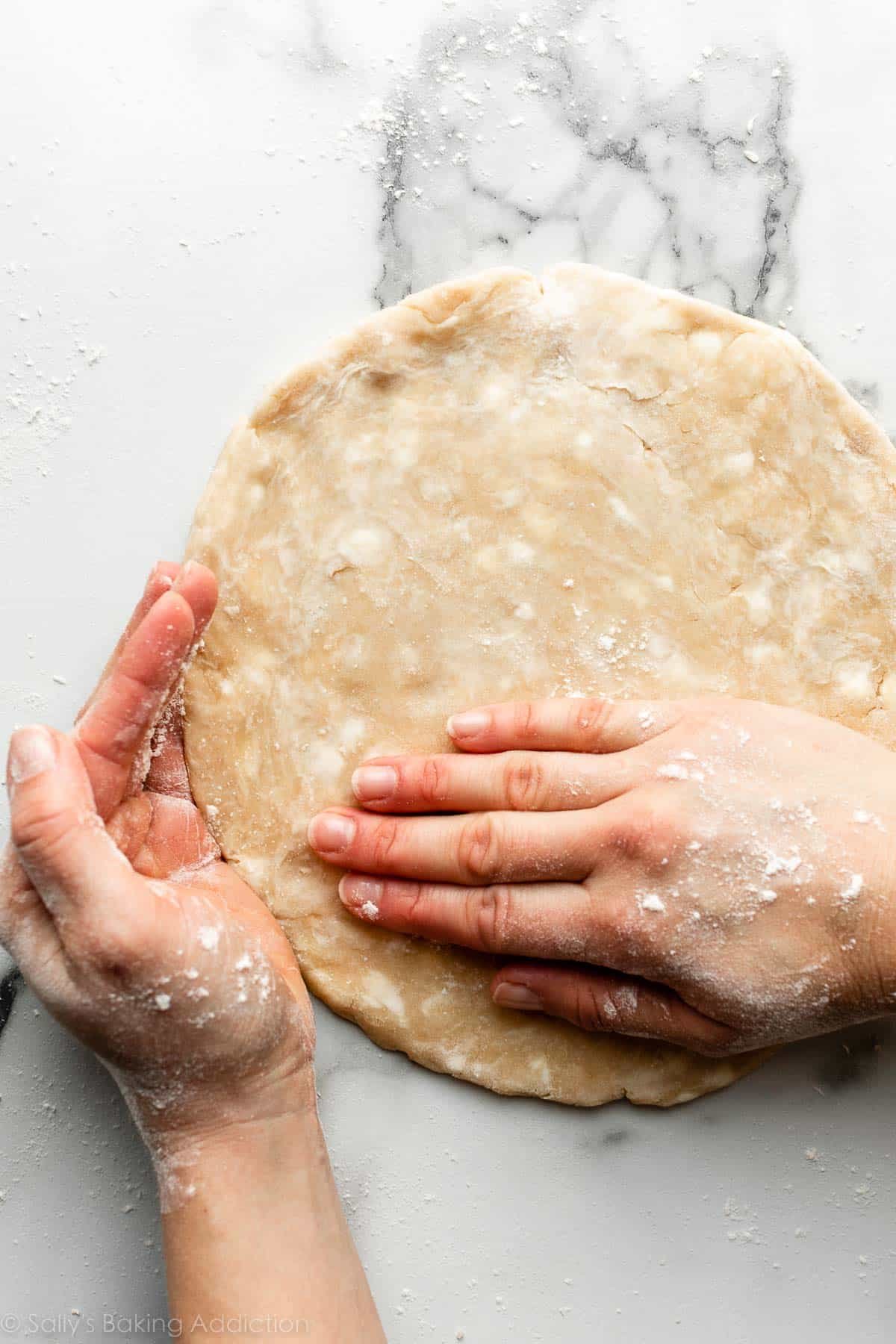
Roll the dough into a thin 12-inch circle, which is the perfect size to fit a 9-inch pie dish. You want enough crust to have some overhang so you can make a decorative edge for your pie.
Your pie dough will be about 1/8-inch thick, which is quite thin.
Success Tip: Since your dough is so thin, use your rolling pin to help transfer the pie crust to the pie dish. Carefully roll one end of the circle of dough gently onto the rolling pin, rolling it back towards you, slowly peeling it off the work surface as you go. Pick it up, and carefully roll it back out over the top of the pie dish. It’s helpful to watch how I do it in the video below.
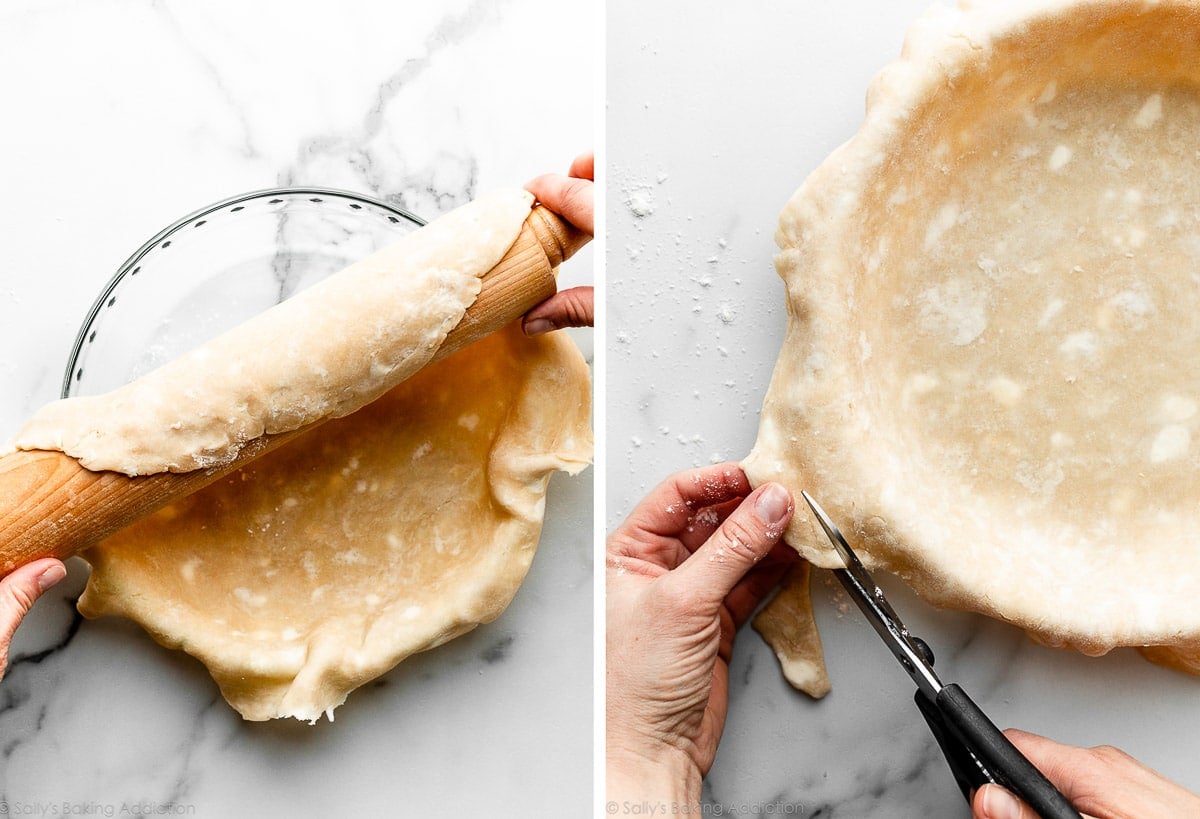
Make sure the pie crust is pretty well centered in the dish, with some overhang all around the sides. Tuck the crust into the pie dish, gently pressing it to the interior all the way around—no air bubbles.
Trim dough around the edges if there’s excess dough in some spots—you want about 1-inch overhang. After you add your pie filling and top crust (such as a lattice pie crust), fold overhang back over and pinch the top and bottom crusts together. Now you can create a pretty edge, such as fluting or crimping. I have a full tutorial on how to crimp and flute pie crust, but here’s a quick overview:
Fluting with fingers: To flute the edges, use a knuckle and 2 fingers to press around the edges of the pie crust, to give it a beautiful and classic scalloped look, like this apple pie.
Crimping with fork: You can also use a fork to crimp the edges, like I do with this peach pie.
Again, review my how to crimp and flute pie crust page and video if you need a little extra help with this step.
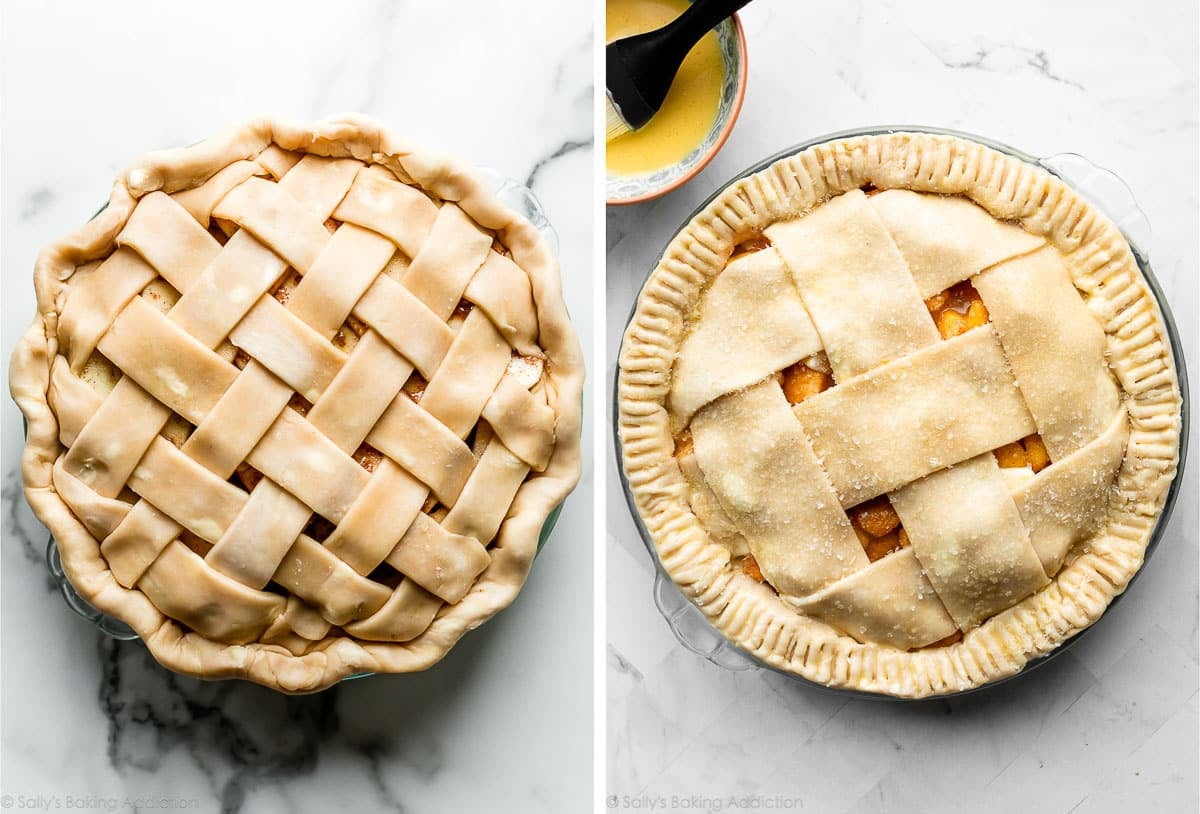
Your pie crust is ready to bake! Follow your pie recipe’s instructions from here; some recipes may call for a fully baked crust, and some may call for a partially baked (par-baked or blind baked) crust. You can read a tutorial on that here in this How to Par-Bake Pie Crust post. And some recipes, like this blueberry pie, don’t require baking the crust at all before adding the filling, because the pie bakes for so long; just spoon/pour the filling right in.
Your pie recipe might call for an egg wash on the dough and for that, use a pastry brush. And if you bake a lot of pies, this list of 10 best pie baking tools will be helpful for you.
Troubleshooting Pie Crust
- Pie crust is tough: Tough crusts are the result of not enough fat in the crust, as well as overworking the dough. Use the recipe below (plenty of fat) and avoid handling the dough more than you need.
- Don’t have enough pie dough: This recipe yields 2 pie crusts. To ensure you have enough pie dough for overhang and a pretty topping, roll your dough out to a 12-inch circle, about 1/8 inch thick.
- Pie crust shrinks down the sides of the dish when baking: This can happen when par-baking a pie crust. See section below.
- Pie dough is dry & cracking around edges when rolling: Use enough ice water when preparing the pie dough. If you work the fats into the dry ingredients too much, the dough will feel too wet before you can add enough water. (And the dough will be dry and thirsty.) Do not overwork the fats in the dry ingredients—you still want those nice crumbles. If it’s too late and you notice the edges of your pie crust are cracking as you roll it out, dip your fingers in ice-cold water and meld the edges back together. Wait a minute, and then try rolling out again.
- Pie dough is falling apart & crumbling when rolling: The dough is likely crumbling because there’s too much fat, and not enough flour and water. Again, this is usually a result of fat being worked in too much, which can easily happen if the ingredients weren’t cold enough. (Refrigerate those dry ingredients before you start!) If it’s too late and the pie dough is crumbling as you roll it out, try adding more water AND more flour. Sprinkle a tiny bit of ice water and flour onto the cracks and crumbled pieces, and gently work it all in with your fingers. Wait a minute, and then try rolling out again.
Gently work ice water drops and flour into your crumbly pie dough to bring it back together:
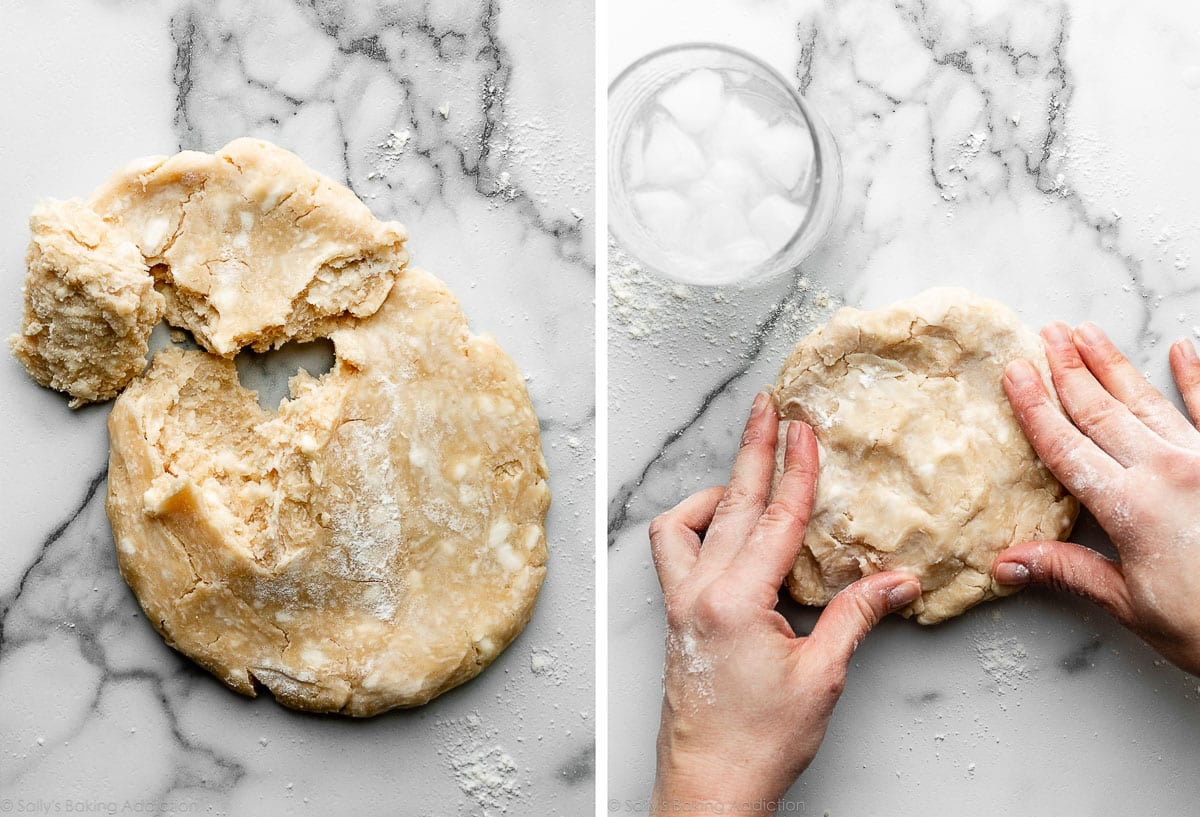
Blind Baking Pie Crust
If your pie recipe requires a fully baked or par-baked pie crust before adding the filling, follow the directions and success tips in this How to Par-Bake Pie Crust guide. You need 2 packs of pie weights, which are metal or ceramic beads that serve to weigh down the crust to prevent the puffing/shrinking. You could use dried beans instead. Whichever you choose, be sure to line the crust with parchment paper, then fill the empty pie crust shell with the weights prior to baking. Without pie weights, the dough will puff up, and then shrink down the sides.
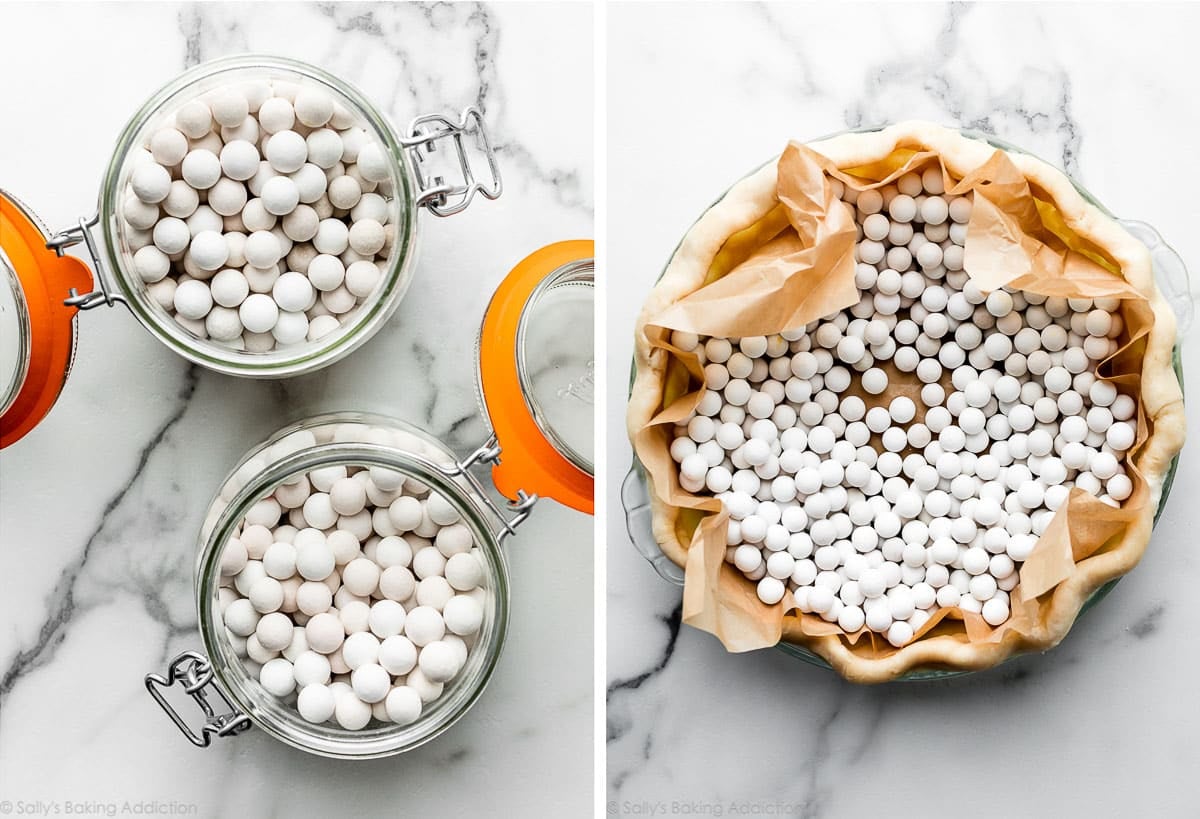
Pie Crust Success Tips
- Use a glass pie dish. I prefer using a glass pie dish when I make pie. Why? Glass dishes conduct heat evenly, which allows the bottom of the crust to bake thoroughly. Also, you’ll be able to see when the sides and bottom of the crust have browned.
- The refrigerator is pie dough’s best friend. Keep everything cold every step of the way: ingredients, the bowl, and the dough before rolling. When taking the pie crust out of the refrigerator to roll out and fill, make sure your pie filling is ready to go. If not, keep the pie crust in the refrigerator until it is.
- Keep dough cold when rolling out: Warm pie dough is unworkable. If the dough becomes too warm when you’re rolling it out, stop what you’re doing, pick it up as gently as you can, put it on a plate or small baking sheet, and then cover and refrigerate it for 10–20 minutes.
- Protect the crust edges from burning: Use a pie crust shield to prevent the edges from burning. A shield keeps the crust edge covered, but the center of the pie exposed, protecting the edges. I usually just make a pie shield out of a piece of aluminum foil. Take a piece of aluminum foil and fold it in half. Cut out a half circle. When you open it back up, you’ll have a square of foil with a circle cut out of the center. If you notice the edges of your pie crust are browning before the pie has fully baked, carefully and gently place the foil over the top of the pie, centering the cut-out hole over the pie. Carefully (obviously it’s very hot!) and lightly tuck the sides of the foil around the pie crust edges, then let the pie finish baking.
- Create a beautiful topping: For designing the top crust, see How to Lattice Pie Crust, How to Braid Pie Crust, or these Pie Crust Designs. And here is my tutorial on How to Crimp and Flute Pie Crust, too.
For more pie crust inspiration, see my graham cracker crust and homemade chocolate pop tarts (with a chocolate crust!).
Print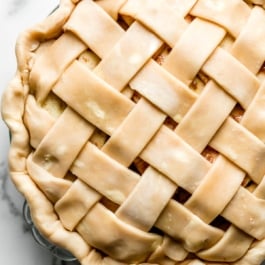
Homemade Buttery Flaky Pie Crust Recipe
- Prep Time: 15 minutes
- Cook Time: 0 minutes
- Total Time: 2 hours, 15 minutes
- Yield: 2 pie crusts (1 lb, 8 ounces dough total)
- Category: Pie
- Method: Baking
- Cuisine: American
Description
This recipe is enough for a double crust pie. If you only need 1 crust for your pie, freeze the other half per the Freezing Instructions below. Is your pie dough tearing, cracking, or crumbling as you try to roll it out? See recipe Notes.
Ingredients
- 2 and 1/2 cups (315g) all-purpose flour (spooned & leveled), plus more for shaping and rolling
- 1 teaspoon salt
- 6 Tablespoons (85g) unsalted butter, chilled and cubed
- 2/3 cup (130g) vegetable shortening, chilled
- 1/2 cup (120ml) ice cold water
Instructions
- Whisk the flour and salt together in a large bowl.
- Add the butter and shortening. Using a pastry cutter or two forks, cut the butter and shortening into the mixture until it resembles coarse meal (pea-sized bits with a few larger bits of fat is OK). In this step, you’re only breaking up the cold fat into tiny little flour-coated pieces; you’re not completely incorporating it. Do not overwork the ingredients.
- Measure 1/2 cup (120ml) of water in a cup. Add ice. Stir it around. From that, measure 1/2 cup (120ml) of water, since the ice has melted a bit. Drizzle the cold water in, 1 Tablespoon (15ml) at a time, and stir with a rubber spatula or wooden spoon after every Tablespoon has been added. Stop adding water when the dough begins to form large clumps. I always use about 1/2 cup of water, and need a little more in dry winter months. Do not add any more water than you need.
- Transfer the pie dough to a floured work surface. Using floured hands, fold the dough into itself until the flour is fully incorporated into the fats. The dough should come together easily and should not feel overly sticky. Avoid overworking the dough. If it feels a bit too dry or crumbly, dip your fingers in the ice water and then continue bringing dough together with your hands. If it feels too sticky, sprinkle on more flour and then continue bringing dough together with your hands. Form it into a ball. Use a sharp knife to cut it in half. If it’s helpful, you should have about 1 lb, 8 ounces dough total (about 680g). Gently flatten each half into 1-inch-thick discs using your hands.
- Wrap each tightly in plastic wrap. Refrigerate for at least 2 hours and up to 5 days.
- After the dough has chilled for at least 2 hours, you can roll it out. Work with one crust at a time, keeping the other in the refrigerator until you’re ready to roll it out. Lightly flour the work surface, rolling pin, and your hands, and sprinkle a little flour on top of the dough. Use gentle-medium force with your rolling pin on the dough—don’t press down too hard on the dough; you’re not mad at it! When rolling dough out, start from the center and work your way out in all directions, turning the dough with your hands as you go. Between passes of the rolling pin, rotate the pie crust and even flip it, to make sure it’s not sticking to your work surface. Sprinkle on a little more flour if it’s sticking; don’t be afraid to use a little more flour. If you notice the dough becoming a lopsided circle as you’re rolling it out, put down the rolling pin and use your hands to help mold the dough back into an even circle. Roll the dough into a very thin 12-inch circle, which is the perfect size to fit a 9-inch pie dish. Your pie dough will be about 1/8 inch thick, which is quite thin. Visible specks of butter and fat in the dough are perfectly normal and expected.
- Because your dough is so thin, use your rolling pin to help transfer the pie crust to the pie dish. Carefully roll one end of the circle of dough gently onto the rolling pin, rolling it back towards you, slowly peeling it off the work surface as you go. Pick it up, and carefully roll it back out over the top of the pie dish. It’s helpful to watch how I do it in the video below.
- Proceed with the pie per your recipe’s instructions. If your dough requires par-baking, see helpful How to Par-Bake Pie Crust tutorial.
Notes
- Make Ahead & Freezing Instructions: Prepare the pie dough through step 5 and freeze the discs for up to 3 months. Thaw overnight in the refrigerator before using in your pie recipe.
- Special Tools (affiliate links): Large Glass Mixing Bowl | Pastry Cutter | Rolling Pin | For more tools you may need to completely assemble and bake your pie, see my 10 Best Pie Baking Tools list.
- Salt: Use regular table salt. If using kosher salt, use 1 and 1/4 teaspoons.
- Shortening: This recipe uses a butter and shortening combination. Butter for flakiness and flavor, and shortening for its high melting point and ability to help the crust hold shape. You can use butter-flavor shortening if desired. If you want to skip the shortening, feel free to try this all-butter pie crust instead. Some readers have substituted lard for shortening in this recipe with success.
- Can I use a food processor? You can use a food processor to bring the dough ingredients together in step 1, but I find it quickly overworks the dough. For best results and a light, flaky crust, I recommend a pastry cutter.
- Pie dough is dry & cracking around edges when rolling: Use enough ice water when preparing the pie dough. If you work the fats into the dry ingredients too much, the dough will feel too wet before you can add enough water. (And the dough will be dry and thirsty.) Do not overwork the fats in the dry ingredients—you still want those nice crumbles. If it’s too late and you notice the edges of your pie crust are cracking as you roll it out, dip your fingers in ice-cold water and meld the edges back together. Wait a minute, and then try rolling out again.
- Pie dough is falling apart & crumbling when rolling: The dough is likely crumbling because there’s too much fat, and not enough flour and water. Again, this is usually a result of fat being worked in too much, which can easily happen if the ingredients weren’t cold enough. (Refrigerate those dry ingredients before you start!) If it’s too late and the pie dough is crumbling as you roll it out, try adding more water AND more flour. Sprinkle a tiny bit of ice water and flour onto the cracks and crumbled pieces, and gently work it all in with your fingers. Wait a minute, and then try rolling out again.
- More Crusts: If you need more than 2 pie crusts, make another separate batch of dough. Doubling or tripling the recipe leads to over- or under-working the dough, which ruins all of your efforts.



















I want to make an apple pie for Thanksgiving. Can l make the pie bake it and then freeze it?
Hi Diane, baked apple pie freezes well for up to 3 months. See recipe Notes there for more make ahead and freezing details!
I need a deep dish homemade pie crust recipe and I’m not finding one that I like. I use your pie crust recipe every Thanksgiving and Christmas but I don’t know that it will work for my new 9 1/2 inch deep dish pie plate.?
Hi Rhonda! It should be just fine rolled a little thinner, but you can always make another batch and add more dough (this recipe makes enough for two crusts).
I need only one pie dough for my recipe. Can I just halve all of the ingredients to make only one pie dough?
That should work just fine, or you can freeze the other half to use another time. See recipe notes for freezing details.
Would it work to use the white solid coconut oil in place of the vegetable shortening?
Hi Elizabeth, some readers have substituted solid and cold coconut oil. However, you may enjoy our all butter pie crust instead.
I used lard instead of shortening and the pie crust is exactly how my great uncle’s pie used to taste. Thanks so much for this recipe.
I’m looking for a really good pastry for butter tarts, but I’ve noticed pie crust differs. Would this recipe work for tarts? What would you suggest? By the way, I’m hooked on your amazing recipes. Thank you !
Hi Cathy, we can’t see why not! Feel free to use this crust recipe with a butter tarts recipe that you enjoy. Thank you for making and trusting our recipes!
This looks delicious! I was wondering if lard or tallow would be okay to use instead of shortening?
Some readers have used lard in place of shortening with success!
Hi Sally! Just a note . I used to say I’d make 3 cakes for you but NO pies! Then I found a crust I’ve used for 50 years (I’m 75). It has 1/4 c of boiling water, 3/4 c spry etc. I’d mix the hot water with the spry till it was like whipped cream and then add the flour. It was easy and always worked. So today I put on my big girl panties and tried your cold method for the first time. SURPRISE it came out great! Now, it seems a lot more work and prep but I saw the butter in the crust when I wrapped it! Thank you for giving me your words of courage and the video so I was brave enough to try it. Can’t wait for Thanks Giving! I’m freezing 4 batches of crust so will let you know how well the pies worked. You do a great job of explanation and even at my age I’m learning A LOT! Your artesian bread is the greatest hit and I actually made cream puffs because of you! Thanks again. Will let you know more later…..
We’re so happy to hear that you’re enjoying this pie crust recipe, Dee! It’s certainly a favorite of ours as well. Thank you for making and trusting our recipes!
I canned a whole bunch of apple pie filling this season. When I saw that refrigerated pie crust was over $4 for two crusts, I decided I needed to keep trying to make homemade crust. This recipe came together much easier than all-butter ones I have tried! I used 1/2 water and 1/2 vodka. I’m not usually a huge fan of shortening, and I was missing a bit of the butter flavor in the crust. Could I increase the butter 2 TBs and decrease shortening 2 TBs? I’m sure you tested and tested and tested again to get the correct ratios, so I’m interested in your thoughts. I did use plain crisco (chilled) perhaps the butter flavor crisco would help too. Love your recipes, have been a follower for years and have many, many favorites! I knew I could count on you for a great pie crust!
Do you cool the shortening also or can it be room temp.?
Chilled is ideal. The colder the ingredients, the easier (and better!) the whole process is.
Hello!
I’ve used this recipie exactly as written and loved it! I now have some leaf lard however that I’d really like to use – how should I go about substituting in this recipie? Thanks in advance!
Hi Megan, Lard should work in place of the shortening without any other changes. Keep the butter. Enjoy!
The one and only pie crust recipe I’ve ever had success with. Turns out flaky and delicious. Thank you!
Do you have any tips for freezing pies in a way that won’t result in a soggy bottom? I’ve tried freezing them baked and unbaked. So far, freezing the dough alone and making the pie when I’m ready for it results in the best pie. With Christmas prep plans underway, I’m hoping you can advise how to freeze whole pies successfully whether baked or unbaked. [In the past, we’ve even bought pies 🙁 and put them in the freezer for a quick need but their bottoms aren’t great either.]
Hi Dianne, I should definitely write up a tutorial on freezing pies. I usually direct readers to this helpful article, which gives a lot of specific advice: https://www.seriouseats.com/how-to-freeze-a-pie-in-advance
Followed this recipe EXACTLY.
Without a doubt it’s the flakiest crust I’ve ever made , completely cooked through even with pumpkin filling.
Thx
Not sure what you mean by shortening. Can I use butter as a substitute?
Hi Susan, vegetable shortening such as Crisco. I do not recommend butter in its place. You can use this all butter pie crust if you’d like instead.
I find that fruit pies can be very wet. Do you recommend pre-baking the pie crust for fruit pies like apple or blueberry?
Thank you
Hi Deborah, we think you’ll find this post about par-baking pie crusts very helpful!
This pie crust recipe is awesome! I tested it with both sweet and savoury fillings, it’s delicious with both. I don’t have a pastry cutter and find the fork method too tedious, so I just use my hands to mix the fats and flour together. It works just fine.
I accidentally put 1 cup of shortening in my pie crust but didn’t discover it until I was doing the washing up and realized I was washing shortening out of the 1/2 cup measure and not the 1/3 cup measure.
The dough is already in the fridge. I hate to throw it out but I’m also concerned about trying to add more flour at this point.
Any guidance? Thanks!
Hi Karen, unfortunately, there’s not much you can do at that point. Adding more flour would likely overwork the dough and you’d want to increase the water, butter, and salt proportionally as well. Thank you so much for giving it a try!
Thank you! I ended up going ahead because I hate throwing anything out. Rolling the crust out was quite challenging, required a LOT of flour, but I managed to roll out bottoms and tops to make your double-crust chicken pies, and they are fantastic! All the thumbs up! The crust itself, while tasty, was incredibly crumbly after baking. It would effectively turn to sand when you cut into it.
So be warned, fellow bakers – double check what measuring cup you have in your hand before you measure and add your ingredients!
I’m anxious to try this. I only have butter flavored crisp shortening. Can I use that in place of shortening with butter or only use butter flavored shortening (without additional butter) since it might be to buttery?
Hi Wendi, you can use the butter flavored shortening here along with the butter — it won’t taste too buttery. We don’t recommend using all shortening.
I am very excited to make my first homemade pie dough using your recipe. It looks amazing and am also using your pumpkin pie recipe! Can you tell me when I should use the pie crust shield. Is it while the crust is pre-baking, baking with the filling or both?
Hi Stephanie! The pie shield is typically used during the main baking period, about half way through the baking time. This ensures the pie crust has time to bake through, but not over bake while the remainder of the pie continues to bake. For the pumpkin pie recipe in particular, we recommend using a pie shield starting around the 25 minute mark. Hope this helps and that you love both recipes!
Hi, Sally and team! This is the best pie crust ever. Can I use cake or bread flour as a substitute for this recipe? I’m about 80 grams short of all-purpose flour and I need to make this pie dough tonight. Thanks in advance!
Hi Charla, We don’t recommend bread flour for pie crust. It would yield a very chewy texture, which is perfect for bread, bagels, etc. but not for a tender, flaky crust. It’s best to stick to all-purpose flour here.
This is my first time trying to make a pie! Just wondering if I can prep an apple filling the night before as well? Do I leave the apple mixture uncooked in the fridge?
Thanks!
Hi Mary Ana, If you’re using our apple pie recipe, it’s fine to leave the prepared mixture in the fridge overnight. We hope your first pie turns out great!
I made this recipe and it was just great! It was flaky and crispy. Thanks a lot for the detailed description.
Can I use oil in place of shortening, I don’t have Crisco
Hi Karen, oil is not a suitable replacement in this dough. Instead, try my all butter pie crust.
HI Sally. Love your recipes!. One reader asked about using the King Arthur flour, which she said comes to 300gms for 2 1/2 cups of flour, according to the King Arthur measurements ( 120 gms per cup). Your recipe calls for 315 gms of flour. I did not find a reply to this in your reply box. Could you please let me know if I should use 300gms of flour or 315 gms if I use the King Arthur flour. Thank you.
Blessings,
Brenda
The pie crust turned out fantastic! It tasted amazing – I used it with the apple hand pies.
Best pie crust I have ever made! I was skeptical with shortening being the main fat, but it tastes sooooo buttery! Wow! I absolutely love the texture an taste of this crust.
I have made this with both just the icee water and some where I add vodka for half the liquid. Highly recommend using vodka for half the cold liquid as it really seems to helps the dough hold together better and was very forgiving with overworking it on occasion.
Thanks for responding, Stephanie. I’m so excited! I made my very first pie crust (I’m 67 years old!) I have always been intimidated by the thought of making my own crust but after reading the label on the store bought refrigerated version with all the preservatives I was determined to try it. I made it 2 days ago, following Sally’s directions exactly. The dough came together with a little less than 1/2 cup of ice water. I put half in the freezer and the other half in the fridge until I had time to make the pumpkin pie. When I got it out to roll it it seemed too wet! After my initial shock and disappointment I decided to proceed and see if it would work. I tried to hurry since I knew it was getting warmer. I managed to roll it out (sprinkling flour on the counter) and get it in the pie dish but it was getting soggy. I decided to put it in the freezer while I mixed up the filling which made it easier to flute when I removed it. It’s in the oven now so…fingers crossed! I guess I must have added too much ice water somehow even though I added it 1 T at a time just like the directions say. I’ll let you know how it turns out. Thanks for your help.
Which brand or type of shortening do you recommend?
Hi Dhyanna, we typically use Crisco vegetable shortening (not sponsored, just what we usually reach for!), but you can use any brand of vegetable shortening that you prefer.
I am known for my pie crusts in our neighborhood and family. I’ve been using a basic Betty Crocker recipe for years. But since I found your web site and signed up for your emails, I have found some great new recipes (Strawberry Cream Cheese Pie). I decided to try your buttery flaky pie crust recipe that uses butter as well as the shortening I had been using. Your recipe is so good, I am an convert to your recipe. To think I’ve been doing this wrong all these years. Thanks so much for this pie crust recipe!
So happy to read this, Ralph! Thank you so much for giving our recipe a try.
I love this pie crust! How would you adjust the ingredients to make 2 crusts for a 10 inch pie?
Hi Beth! Instead of scaling up the recipe (which may not work very well), I would actually make 2 separate batches of this pie dough. You will have 4 pie dough discs. Freeze one of them to use at a different time and use 3 of them. Cut the 3rd one in half and combine it with the 1st and 2nd to make 2 large discs. Then use those for your double crust 10-inch pie. I hope this makes sense!
Thanks! That sounds perfect. The extra crust can be used to make your quiche recipe which I also love.
I’m trying to decide which pie crust recipe to try first. I’m curious why the all butter recipe calls for 2 tsp sugar and this one has no sugar?
Hi Judy, While it’s not needed in this recipe, for the all butter crust we find the small addition improves the crust’s flavor and enhances browning. The sugar crystals also help break down the hard pieces of butter. It’s not enough sugar to make it taste sweet!
What is your opinion of grating frozen butter into the flour ? I have never been very successful at using a pastry blender to assimilate larger cubes.